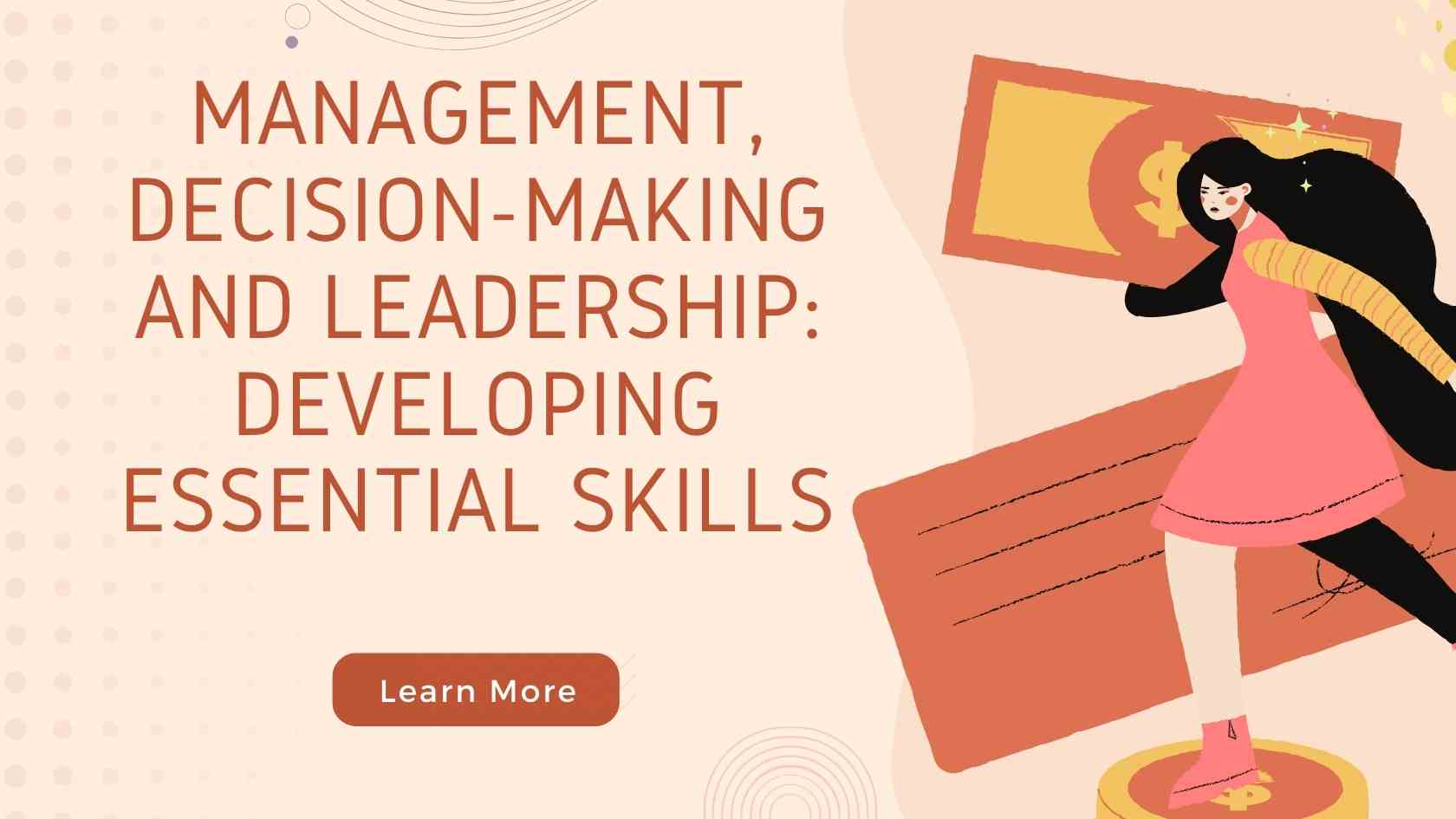Being a good leader in the sphere of business means more than just managing people. It’s about understanding how to motivate, recognise, and unite teams for success.
Motivating and rewarding people means more than money. It’s about making them feel valued and giving them a sense of purpose and freedom at work. Creating a positive work environment where everyone can communicate and be creative is super important too. It keeps people engaged and makes them want to stick around.
And to lead well, you’ve got to get everyone on the same page, working toward the same goals. It’s like juggling different things at once – motivating, creating a great atmosphere, and getting everyone moving in the right direction.
Taking up a general management program will teach you about how organisations work, how to make smart decisions, and how to be a great leader. You learn practical skills to build solid teams and connect with people from different industries, and all in all, learn from their experiences.
In this blog, we’ll explore how to motivate, reward, build a great culture, and get everyone working together. Let’s explore some strategies that can help make teams perform exceptionally well and drive success for the whole organisation.
Introduction: Managing Performance and Leading Teams
Managing performance and leading teams are fundamental aspects of effective leadership within any organisation. Both concepts are interconnected and crucial for achieving organisational goals and maximising productivity.
Effective performance management forms the foundation of organisational success. It entails a systematic approach to optimising individual and team performance, ensuring alignment with broader strategic goals and objectives. The key elements of performance management include:-
- Objective setting: Establishing clear objectives stands as a fundamental pillar in performance management. It involves defining precise and achievable goals for individuals and teams, providing them with a clear direction and purpose in their work.
- KPI definition: Key Performance Indicators (KPIs) serve as vital signposts along the journey to success. Establishing measurable indicators enables organisations to monitor progress, assess performance, and gauge the effectiveness of their actions.
- Performance assessment: Regularly evaluating and enhancing individual and team performance is pivotal. This continual assessment facilitates the identification of strengths, areas for improvement, and the implementation of strategies aimed at maximising productivity.
- Framework creation: Creating a structured framework involves establishing systems and mechanisms that aid employees in understanding their roles and responsibilities. It ensures they receive consistent feedback and support for continuous growth and development.
- Resource provision: Providing essential support and resources plays a critical role in enabling employees to perform at their best. From training programmes to access to necessary tools, these resources ensure employees have what they need to succeed.
- Processes involved: Performance management encompasses diverse processes such as performance appraisals, collaborative goal setting, skill development initiatives, and feedback mechanisms. These processes collectively contribute to enhancing overall performance within the organisation.
Team leadership, on the other hand, means guiding your team in the right direction and helping everyone work well together. The key elements of leading teams include:-
- Inspiration and motivation: Good leaders inspire and motivate their team by sharing a clear vision and getting everyone excited and committed to it.
- Promoting collaboration: Encouraging teamwork and making sure everyone talks openly is important. When people work together, they often find better ways to do things and get more done.
- Trust building: Making sure everyone trusts each other is key. Leaders do this by being honest, reliable, and fair, so everyone feels safe and respected in the team.
- Conflict resolution: Solving problems between team members quickly and calmly is important to keep the team happy and working well together.
- Strength utilisation: Good leaders know what each person is good at and give them tasks that suit their strengths. This makes the team stronger overall.
- Understanding dynamics: Understanding how the team works together and appreciating differences between team members helps create a better and more innovative team.
- Culture promotion: Creating a positive work environment where everyone feels valued and encouraged to share ideas leads to a happier and more productive team.
Integrating these facets creates high-performing teams. Aligning performance management strategies with effective team leadership cultivates a cohesive, motivated, and productive workforce. Proficient leaders in both realms identify strengths, tackle weaknesses, offer support, and guide their teams to success.
Moreover, effective leadership extends beyond task oversight. It involves fostering an environment conducive to innovation, continuous growth, and learning. Leaders accomplish this through regular feedback, coaching, and mentorship, aiding employees’ professional and personal development, thus enhancing job satisfaction and retention.
Understanding Motivation for Engaged Teams
Motivation stands as the key driving force behind engaged and productive teams within any company. When individuals feel motivated, their commitment to their work amplifies, leading to more effective collaboration and a dedicated contribution towards shared objectives.
Motivated team members showcase a heightened sense of responsibility and willingly invest their efforts into their tasks, going above and beyond their roles. This intrinsic drive fosters an environment where creativity flourishes, initiative is embraced, and job satisfaction rises. Moreover, motivated individuals exhibit resilience in the face of challenges, displaying adaptability and a proactive approach to problem-solving.
Ultimately, a motivated workforce fuels an organisation’s success, fostering an enthusiastic, collaborative, and goal-oriented environment where every member is committed to achieving collective success.
Rewarding Employees Beyond Money
Employee motivation comprises more than solely financial rewards. Non-monetary incentives are pivotal in nurturing a fulfilling work environment and enhancing employee engagement. Here’s a comprehensive overview of various non-financial rewards that profoundly impact employee motivation:
- Recognition and appreciation: Acknowledgement of employees’ contributions, whether through public recognition, personalised notes, or awards ceremonies, fosters a sense of accomplishment and boosts morale. Being appreciated for their efforts enhances job satisfaction, encouraging employees to excel.
- Flexible work arrangements: Offering flexibility in work schedules or remote work options demonstrates an understanding of employees’ diverse needs. This flexibility enhances work-life balance, empowering employees to manage personal responsibilities alongside work commitments.
- Meaningful tasks and responsibilities: Assigning challenging, purposeful tasks aligned with employees’ skills and interests fosters a sense of purpose and accomplishment. Feeling that their work contributes meaningfully to the organisation’s goals boosts motivation.
- Supportive work environment: Cultivating a workplace culture rooted in open communication, approachable leadership, and a sense of community creates a supportive atmosphere. Feeling valued and supported by peers and management enhances employee motivation.
- Work-life balance initiatives: Implementing initiatives focused on wellness, mental health support, or family-friendly policies demonstrates care for employees’ overall well-being. Such initiatives increase motivation by showcasing a commitment to their holistic welfare.
- Autonomy and empowerment: Granting autonomy and decision-making authority empowers employees to take ownership of their tasks. This trust and responsibility foster a sense of empowerment and innovation among employees.
- Personalised benefits: Tailoring benefits or rewards to suit individual preferences demonstrates an understanding of employees’ unique needs. Personalised benefits reinforce a sense of appreciation and understanding, thereby boosting motivation.
These non-monetary incentives collectively contribute to employees feeling valued, motivated, and engaged in their roles. They create a conducive work environment where individuals are inspired to perform at their best and are dedicated to achieving the organisation’s objectives.
Effective Leadership Skills
Effective leadership encompasses various methods and approaches tailored to inspire, guide, and empower individuals and teams. Here are several methods and practices often employed by effective leaders:
- Visionary leadership: Great leaders not only envision the future of the organisation but also effectively communicate this vision to their teams. They craft a compelling narrative that resonates with employees, inspiring them to work towards common goals.
By consistently reinforcing this vision and linking it to the day-to-day tasks, leaders create a sense of purpose and direction, fostering enthusiasm and dedication among team members.
- Leading by example: Effective leaders understand the significance of embodying the values and work ethic they expect from their team. They demonstrate integrity, resilience, commitment, and dedication in their actions, becoming role models for their employees.
Leading by example helps in building trust and respect, as team members are more likely to follow leaders who demonstrate the behaviours they advocate.
- Empowerment and delegation: Empowering employees involves entrusting them with responsibilities and authority. Effective leaders recognise the strengths and capabilities of their team members, allowing them the autonomy to make decisions and take ownership of their work.
This not only fosters a sense of trust and confidence but also encourages creativity and innovation, as individuals feel valued and empowered to contribute ideas and solutions.
- Effective communication: Clear and open communication is the cornerstone of effective leadership. Leaders should not only convey their thoughts and ideas clearly but also actively listen to their team members.
By fostering an environment where everyone feels heard and understood, leaders create opportunities for constructive feedback, aligning everyone towards the shared vision and ensuring that goals and expectations are well-understood by all.
- Adaptability and flexibility: In today’s dynamic business landscape, change is constant. Effective leaders recognise the need to navigate through uncertain situations and adapt their strategies accordingly.
Being adaptable and flexible allows leaders to adjust plans and approaches in response to evolving circumstances. This ability to pivot ensures that the team remains agile and responsive, enabling them to thrive even in unpredictable environments.
- Supporting and developing team members: Effective leaders understand the importance of investing in their team’s growth and development. They provide mentorship, coaching, and ample learning opportunities to enhance their skills and capabilities.
This investment not only helps individuals unlock their potential but also contributes to a more skilled and motivated workforce. Supporting and developing team members fosters loyalty, engagement, and a sense of commitment, ultimately leading to improved team performance and success.
- Emotional intelligence: Leaders with high emotional intelligence possess a deep understanding of emotions, both in themselves and others. They effectively manage their own emotions and reactions while demonstrating empathy and understanding towards their team members.
Emotional intelligence enables leaders to handle conflicts with diplomacy, build stronger relationships, and create a positive work environment. It also allows them to inspire and motivate their teams by recognising and responding to their emotional needs.
- Decision-making skills: Effective leaders excel in making well-informed decisions. They gather and evaluate relevant information, consider various perspectives, and assess potential outcomes before making timely and decisive choices. Decisions are aligned with the organisation’s goals and values, ensuring that they contribute to the overall direction and success of the company.
- Building and nurturing relationships: Strong relationships are the foundation of effective leadership. Leaders focus on cultivating robust connections within their teams and with external stakeholders. Within the team, leaders foster an environment of trust, open communication, and mutual respect.
This enables team members to collaborate effectively, share ideas, and work towards common goals. Additionally, strong relationships with external stakeholders such as clients, partners, or other relevant entities are equally vital. These relationships build trust and goodwill, facilitating smoother collaborations and enhancing the organisation’s reputation.
- Continuous learning and improvement: As an effective leader, you need to understand the importance of continuous learning and personal growth. Actively seek feedback from peers, team members, and mentors to gain insights into their leadership style and areas for improvement. Reflection on past experiences will allow you to learn from successes and failures alike.
Furthermore, prioritise your personal development by seeking opportunities for training, education, and skill enhancement. By embracing a mindset of continuous improvement, you need to stay updated with industry trends, hone your leadership skills, and adapt to changing circumstances more effectively, ultimately benefiting your company and your team.
Leadership Strategies: Steps to Make Smart Decisions as a Leader
Effective decision-making as a leader involves a structured approach aimed at addressing problems or thoughtfully achieving objectives. A general management program or good leadership and management courses can teach you leadership strategies in more detail, however, here are some of the steps to make informed and prudent decisions:
- Define the problem/objective: The initial step is to clearly articulate the issue at hand or the goal to be achieved. This involves specifying the parameters, boundaries, and significance of the problem or objective to ensure a focused approach.
- Gather information: Acquiring pertinent information is crucial. This involves collecting relevant data, insights, and perspectives related to the situation. Diverse sources provide a comprehensive understanding, aiding in better decision-making.
- Identify alternatives: Generating multiple potential solutions or approaches is pivotal. Encourage creative brainstorming sessions to explore various alternatives that could address the problem or fulfil the objective.
- Evaluate options: Assess the strengths and weaknesses of each alternative. Consider potential risks, benefits, and alignment with organisational values and goals. A thorough evaluation helps in choosing the most suitable option.
- Seek input and collaboration: Involve stakeholders, team members, or subject matter experts. Their diverse perspectives offer valuable insights, fostering a more well-rounded decision and increasing buy-in.
- Make a decision: Based on a comprehensive analysis, make a timely decision. Procrastination should be avoided, but decisions should not be rushed. It’s essential to strike a balance between efficiency and thoroughness.
- Implement the decision: Develop an actionable plan to execute the chosen solution. Clear communication, delegation of responsibilities, and provision of necessary resources are crucial for successful implementation.
- Monitor and adapt: Continuous monitoring of the decision’s progress and outcomes is vital. Be open to adapting and making adjustments if needed. Flexibility is key in responding to changing circumstances.
- Learn from decisions: Reflect on each decision-making process, irrespective of the outcome. Identifying strengths and areas for improvement is essential for refining future decision-making strategies.
- Develop decision-making skills: Enhance decision-making abilities by staying informed, seeking feedback, and investing in personal development. Opportunities such as workshops or literature can further strengthen these skills.
- Use technology and tools: Leverage available technological tools and decision-making frameworks to streamline the process. These resources can provide valuable insights, aiding in making informed decisions.
- Trust and delegate: Encourage a culture of accountability and innovation within the team. Delegate decision-making authority when appropriate, trusting the expertise of team members.
Mastering the art of decision-making involves a balance between analysis and intuition, embracing both rational and emotional aspects. Employing a structured approach while remaining adaptable and open-minded greatly enhances leadership decision-making skills.
Practical Tools for Real-World Leadership
Here are some practical tools that can be beneficial for real-world leadership:
- SWOT Analysis: This tool assesses Strengths, Weaknesses, Opportunities, and Threats. It helps leaders understand the current state of their organisation, enabling them to leverage strengths, address weaknesses, seize opportunities, and mitigate threats.
- SMART Goals Framework: Setting Specific, Measurable, Achievable, Relevant, and Time-bound (SMART) goals helps in defining clear objectives for teams. It aids in better planning, monitoring progress, and achieving desired outcomes.
- Decision Matrix: Useful for evaluating options by creating a grid that considers various criteria and their relative importance. It helps in comparing choices systematically to make informed decisions.
- 360-Degree Feedback: Gathering feedback from various sources, including peers, subordinates, and supervisors, provides a holistic view of a leader’s performance. This tool aids in personal development by identifying strengths and areas for improvement.
- Performance Dashboard or Balanced Scorecard: These tools offer a visual representation of key performance indicators (KPIs) relevant to the organisation’s goals. It helps leaders track progress and make data-driven decisions.
- Pareto Principle (80/20 Rule): This principle suggests that roughly 80% of effects come from 20% of causes. It helps leaders focus on the most critical aspects that yield the greatest results.
- GROW Model (Goal, Reality, Options, Will): This coaching framework assists in setting goals, understanding the current reality, exploring options, and determining the will or commitment to act. It’s effective for guiding individuals or teams towards their objectives.
- Emotional Intelligence Assessment: Tools such as EQ assessments help leaders understand their emotional intelligence strengths and weaknesses. Enhancing emotional intelligence fosters better communication, empathy, and leadership effectiveness.
- Time Management Matrix (Eisenhower Matrix): This matrix categorises tasks based on urgency and importance, assisting leaders in prioritising tasks and focusing on what truly matters.
- Root Cause Analysis: This tool aids in identifying the underlying causes of problems or issues within an organisation. By addressing root causes, leaders can implement more effective and long-lasting solutions.
- Change Management Models (e.g., Kotter’s 8-Step Model): These models provide a structured approach to managing organisational change. They guide leaders through the process of initiating and implementing change effectively.
These practical tools are invaluable for leaders in the real world, offering frameworks and methods to enhance decision-making, goal-setting, team management, and overall leadership effectiveness.
Conclusion
The art of managing performance and leading teams can be mastered by first understanding the nuances of motivation, and rewards, fostering a positive culture, and aligning everyone’s efforts. Prioritising these aspects brings forth an environment where employees feel valued, engaged, and aligned with the company’s objectives.
Keeping this in mind, enrolling in leadership and management courses like the General Management Programme in Dubai offered by Imarticus Learning becomes invaluable. These courses delve into effective leadership techniques, organisational dynamics, and strategic decision-making. They provide practical tools to navigate real-world challenges, empowering individuals to drive exceptional team performance and organisational success.
By embracing these principles alongside specialised education, individuals not only enhance their current capabilities but also establish a sturdy foundation for a prosperous future in this dynamic field.










